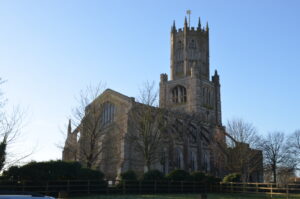
St. Mary and All Saints, Fotheringhay.
By the time autumn had set in and the nights were getting longer in October, 1452, there had already been a castle at Fotheringhay, Northamptonshire for 400 years, dating back to the Norman invasion. It had passed through numerous hands over the centuries including David I King of Scotland’s, until it was confiscated and given to William the Marshall who was one of the, if not the most famous medieval Knight in history by King John. King John’s son, Henry III eventually gained possession of it and it remained in royal control through the reign of Edward III. He gifted it to his son Edmund Langley, Duke of York in 1377 who spent much money enlarging and developing the castle.
During the late 13th century, a college of priests was established at the castle before being transferred to the parish church, St. Mary and All Saints. This was rebuilt in a size and scale befitting the college, and also as the York family church. The church that remains echos the glory of this building, and unfortunately all that remains of it today is a small amount of masonry.
When Edmund died, it eventually came into the possession of his nephew Richard, the 3rd Duke of York. Richard was cousin to the Lancastrian King of England, Henry VI, and could trace his lineage back to the 2nd and 4th sons of King Edward III.
In October 1452, the castle was at the height of its power and importance, Richard, and his Duchess Cecily were based there, as it was one of their main residences after spending years abroad in France and in Ireland. They had been married for over 20 years, having been betrothed young and Cecily was about to give birth to their 12th child.
After what was said to be a difficult delivery, a son was born named for his father and baptised Richard, either in the castle chapel or the nearby St. Mary and All Saint’s church. The small boy was to be their youngest child to survive adulthood, and sadly his parents would come to know the loss of at least 6 children.
There are stories and myths surrounding the baby Richard, that he was sickly and unlikely to survive, not helped by the rhyme written around the time of his birth that stated: ‘Richard liveth yet’. It was most likely a reference to high mortality rates in babies, more than a direct reference to Richard’s health. And then of course there were the references after the Tudor’s came to the throne, that he was born with shoulder length hair and a full set of teeth which is ludicrous and yet other references of the time are taken as fact.
But we digress.
The Wars of the Roses were brewing on the horizon, but for the first 7 or so years of Richard’s life, it appears that he lived in relative peace, with much of his time spent growing up at Fotheringhay.
At the time of his birth, it would have been unthought of that Richard would become King.
For one thing, he wasn’t in the direct line of succession. Even if his father had won the Battle of Wakefield, defeated the Lancastrians and become King, Richard still have been 4th in line to the throne after his 3 brothers.
Even when his brother King Edward IV became King in 1461, he was only destined to fulfill his role as his loyal brother and Lord of the North, the Duke of Gloucester.

Recent Comments